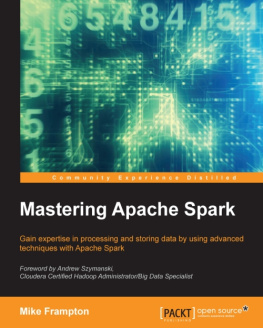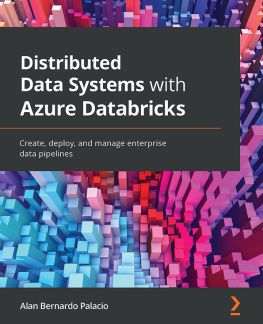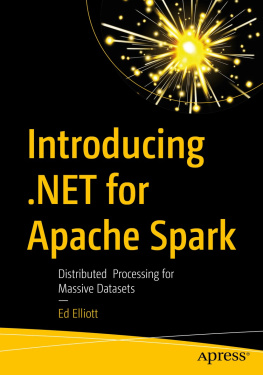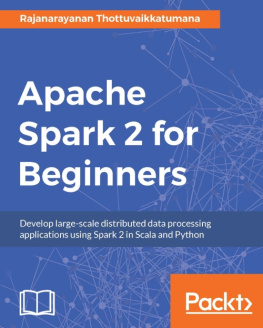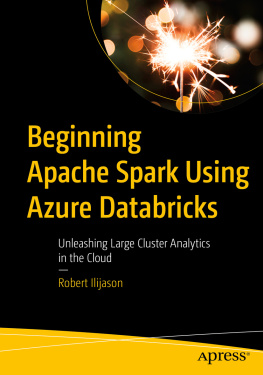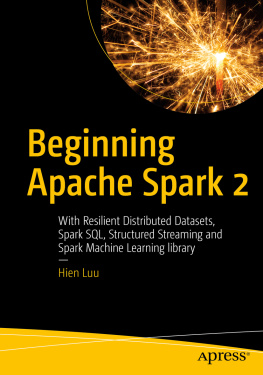Rupali R. Shrawane
Foreword
Big data is getting bigger and bigger day by day. And I don't mean tera, peta, exa, zetta, and yotta bytes of data collected all over the world every day. I refer to complexity and number of components utilized in any decent and respectable big data ecosystem. Never mind the technical nitties grittiesjust keeping up with terminologies, new buzzwords, and hypes popping up all the time can be a real challenge in itself. By the time you have mastered them all, and put your hard-earned knowledge to practice, you will discover that half of them are old and inefficient, and nobody uses them anymore. Spark is not one of those "here today, gone tomorrow" fads. Spark is here to stay with us for the foreseeable future, and it is well worth to get your teeth into it in order to get some value out of your data NOW, rather than in some, errr, unforeseeable future. Spark and the technologies built on top of it are the next crucial step in the big data evolution. They offer 100x faster in-memory, and 10x on disk processing speeds in comparison to the traditional Hadoop jobs.
There's no better way of getting to know Spark than by reading this book, written by Mike Frampton, a colleague of mine, whom I first met many, many years ago and have kept in touch ever since. Mike's main professional interest has always been data and in pre-big data days, he worked on data warehousing, processing, and analyzing projects for major corporations. He experienced the inefficiencies, poor value, and frustrations that the traditional methodologies of crunching the data offer first hand. So understanding big data, what it offers, where it is coming from, and where it is heading, and is intrinsically intuitive to him. Mike wholeheartedly embraced big data the moment it arrived, and has been devoted to it ever since. He practices what he preaches, and is not in it for money. He is very active in the big data community, writes books, produces presentations on SlideShare and YouTube, and is always first to test-drive the new, emerging products.
Mike's passion for big data, as you will find out, is highly infectious, and he is always one step ahead, exploring the new and innovative ways big data is used for. No wonder that in this book, he will teach you how to use Spark in conjunction with the very latest technologies; some of them are still in development stage, such as machine learning and Neural Network. But fear not, Mike will carefully guide you step by step, ensuring that you will have a direct, personal experience of the power and usefulness of these technologies, and are able to put them in practice immediately.
Andrew Szymanski
Cloudera Certified Hadoop Administrator/Big Data Specialist
About the Author
Mike Frampton is an IT contractor, blogger, and IT author with a keen interest in new technology and big data. He has worked in the IT industry since 1990 in a range of roles (tester, developer, support, and author). He has also worked in many other sectors (energy, banking, telecoms, and insurance). He now lives by the beach in Paraparaumu, New Zealand, with his wife and teenage son. Being married to a Thai national, he divides his time between Paraparaumu and their house in Roi Et, Thailand, between writing and IT consulting. He is always keen to hear about new ideas and technologies in the areas of big data, AI, IT and hardware, so look him up on LinkedIn (http://linkedin.com/profile/view?id=73219349) or his website (http://www.semtech-solutions.co.nz/#!/pageHome) to ask questions or just to say hi.
I would like to acknowledge the efforts of the open source development community who offer their time, expertise and services in order to help develop projects like Apache Spark. I have been continuously impressed by the speed with which this development takes place, which seems to exceed commercial projects. I would also like to mention the communities that grow around open source products, and people who answer technical questions and make books like this possible.
There are too many people that have helped me technically with this book and I would like to mention a few. I would like to thank Michal Malohlava at http://h2o.ai/ for helping me with H2O, and Arsalan Tavakoli-Shiraji at https://databricks.com/ for answering my many questions. I would also like to thank Kenny Bastani for allowing me to use his Mazerunner product.
Riddhi Tuljapurkar, at Packt, and the book reviewers have put in a sterling effort to help push this book along. Finally, I would like to thank my family who have allowed me the time develop this book through the months of 2015.
About the Reviewers
Andrea Mostosi is a technology enthusiast. Innovation lover since when he was a child, he started his professional job in the early 2000s, and has worked on several projects playing almost every role in the computer science environment. He is currently the CTO at The Fool, a company that tries to make sense of data. During his free time, he likes travelling, running, cooking, biking, reading, observing the sky, and coding.
I would like to thank my wonderful girlfriend Khadija, who lovingly supports me in everything I do. I would also thank my geek friends: Simone M, Daniele V, Luca T, Luigi P, Michele N, Luca O, Luca B, Diego C, and Fabio B. They are the smartest people I know, and comparing myself with them has always pushed me to be better.
Toni Verbeiren received his PhD in theoretical physics in 2003. He has worked on models of artificial neural networks, entailing mathematics, statistics, simulations, (lots of) data, and numerical computations. Since then, he has been active in this industry in a range of domains and roles: infrastructure management and deployment, service and IT management, and ICT/business alignment and enterprise architecture. Around 2010, he started picking up his earlier passion, which is now called Data Science. The combination of data and common sense can be a very powerful basis for making decisions and analyzing risk.

